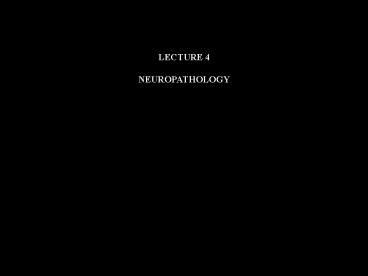Parkinson's Disease - PowerPoint PPT Presentation
1 / 36
Title: Parkinson's Disease
1
LECTURE 4 NEUROPATHOLOGY
2
PARKINSONS DISEASE
James Parkinson, 1817
...involuntary tremulous motion, with lessened
muscular power, in parts not in action and even
when supported with a propensity to bend the
trunk forwards, and to pass from a walking to a
funning pace, the senses and the intellects
uninjured.
3
CLINICAL SYMPTOMS
rhythmic tremor at rest rigidity with cog-wheel
characteristic akinesia
4
STAGES OF PARKINSON'S DISEASE
DOPAMINE
( control)
100
80
ADAPTIVE
60
CAPACITY
40
COMPENSATION
-no symptoms
20
MILD SYMPTOMS
DECOMPENSATION
MARKED SYMPTOMS
0
5
EPIDEMIOLOGY
fifth or sixth decade of life 85
idiopathic prevalence 3 per 1000 cumulative
life-time risk 1 in 40 approximately 1 million
patients no cure
6
ETIOLOGY
Genetic Factors 1999 - examined 17,000 twins
gt 50 years old no genetic effect
lt 50 years old 10 genetic defect Diet ?
vitamins, antioxidants ? ? incidence Smoking ?
? incidence Environment ? incidence in rural
areas dopamine neuron toxins
7
MPTP A Neurotoxin for Dopamine Neurons
- Methylphenyltetrahydropyridine
- contaminant in synthetic heroin
- inhibits electron transport chain
8
TREATMENT
Pharmacology Restore Dopamine
Function Dopamine precursor L-DOPA Dopamine
agonists apomorphine, bromocriptine Inhibitors
of Dopamine degradation selegiline, tolcapone
9
(No Transcript)
10
TREATMENT
Neural Transplants Chromaffin cells fetal
dopamine neurons genetically engineered
cells Surgery Pallidotomy and
Thalamotomy Deep Brain Stimulation
11
Pathophysiology of Parkinsons Disease
Normal
STRIATUM
MOTOR CORTEX
PALLIDUM
THALAMUS
SUBSTANTA NIGRA
Pathology
STRIATUM
MOTOR CORTEX
PALLIDUM
THALAMUS
SUBSTANTA NIGRA
12
Deep Brain Stimulation
13
Huntingtons Disease
- first described by George Huntington in 1872
- onset of disease in fourth or fifth decade of
life - inherited
14
Symptoms
- General
- chorea, dementia
- First signs
- absentmindedness, irritability
- depression, fidgeting, clumsiness
- Later signs
- uncontrolled (i.e., choreiform) movements
- confinement to wheel chair or bed
- speech first slurred than incomprehensible
- mental functions deteriorate
15
Epidemiology
- incidence 5 per 100,000
- 150,000 at risk in US
- affects men and women equally
- each child of an affected parent has
- 50 chance of inheritance
- no current treatment
16
Etiology
- autosomal dominant trait
- HD patients in eastern US from two ancestors
- - emigrated to salem, MA in 1630
- HD patients in Venezuela from single ancestor
(1630)
17
Biochemistry
General 1. Loss of cholinergic and GABAergic
neurons in striatum 2. Disinhibition of
nigrostriatal dopamine neurons
18
Comparison
19
Criteria for Diagnosis of Schizophrenia
1. continuously ill for at least six months 2.
one or more of the following a. bizarre
delusions (1) persecution, control by outside
force b. auditory hallucinations (1) hearing
voices c. disorder of thought (1) loss of
association between ideas (2) poverty of
speech (3) loss of emotional responsiveness
("flattening of affect")
20
Two Overlapping Syndromes
1. positive-syndrome a. delusions,
hallucinations, psychotic episodes b. respond
well to antipyschotic drugs 2. negative-syndromes
a. flattening of affect, poverty of speech,
poor social adjustment b. respond less well to
antipsychotic drugs
21
Epidemiology
- rate varies throughout the world
- - 1 of population in the US
- - slightly higher in Ireland, Yugoslavia and
Scandinavia - typically affects patients in their twenties and
thirties
22
Etiology
- genetic component
- non-Mendelian
- perhaps due to
- 10 different genes
23
Etiology
- problem with fetal brain development
- - due to viral infection in prenatal second
trimester
24
Treatment
Neuroleptics - bind dopamine receptors
25
(No Transcript)
26
Neuroleptics
- Problems with classical or typical neuroleptics
- extrapyramidal side effects
- - tardive dyskinesia - involuntary movements
- - Parkinson-like movements
27
Schizoid Personality
- Symptoms
- suspicious
- preference for isolation
- preoccupation with unusual beliefs
- vague and digressive speech
- eccentric dress
- Etiology
- common in families of schizophrenics
- fewer number of schizophrenic genes
28
Criteria for Diagnosis of Depression
- Abnormal sense of sadness, despair and
- bleak feelings about the future
- disordered eating and weight control
- disordered sleeping
- diminished sexual interest
29
Epidemiology
- 5 to 8 of the US population
- 10 if include manic depression
30
Etiology
- Genetic predisposition ??
- Non-Mendelian
- higher incidence in
- - monozygotic compared to dizygotic twins
- - in children adopted from depressed patients
31
Neurobiology
- Biogenic Amine Hypothesis
- dopamine, norepinephrine and serotonin
32
Treatment of Depression
1. Electroconvulsive therapy - full remission or
marked improvement in 90 of well defined
depression - short lasting? 2. Antidepressant
pharmacology - effectively treat 70 of all
patients
33
Pharmacology of Depression
- Tricyclic antidepressants - block
- amine uptake
- 1. Desipramine (NE)
- 2. Imipramine (5-HT and NE)
- Atypical antidepressants
- 1. Nomifensine (DA and NE)
- 2. Buproprion (DA, 5-HT and NE)
34
(No Transcript)
35
Pharmacology of Depression
- monoamine oxidase inhibitors
- (MAO-A)
- 1. Phenelzine
- 2. Pargyline
- specific serotonin uptake inhibitors (SSI)
- 1. Fluoxetine (Prozac)
36
Click picture to return to SWEPT home































